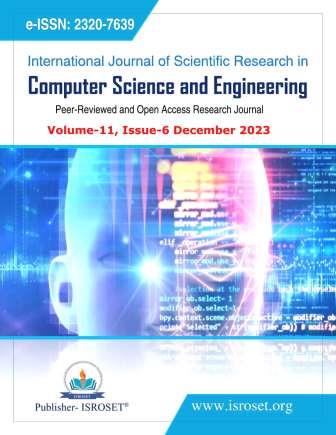Analysis of Wireless Link Performance under Quasi-Orthogonal Space-Time Block Codes
Keywords:
Orthogonal space time block code (OSTBC), wireless communication, Zero forcing decoding technique, Alamouti scheme, multiple input multiple output (MIMO) systemsAbstract
In wireless communication, the primary focus lies on the interference among symbols rather than noise. The utilization of orthogonal space-time block codes (OSTBC) has shown to be a highly effective method for implementing the notion of interference immunity. When the number of antennas exceeds two, it becomes unfeasible to provide complete transmission, as observed in the Alamouti system. In this particular scenario, quasi-orthogonal space-time block coding (STBC) presents itself as an alternative approach, albeit with the drawback of introducing some level of interference. The zero forcing (ZF) decoding approach is occasionally employed to transform quasi-orthogonal space-time block codes (STBCs) into fully orthogonal codes, but at the cost of increased noise. This study aims to analyze the influence of channel gain on the amplification of noise. Encouraging results have been obtained in this regard.
References
Jin, Guiyue, Chaoyue Zhao, Zhuyun Fan, and Jiyu Jin. "Antenna selection in TDD massive MIMO systems," Mobile Networks and Applications, vol. 26, pp.1831-1837, 2021.
V.Tarokh, H. Jafarkhani, A.R. Calderbank, “Space-Time block codes from orthogonal designs,” IEEE Trans.Inf. Theory, vol.45, no. 5, pp. 1456-1467, 1999.
Yang, P., Zhu, J., Xiao, Y. and Chen, Z., “Antenna selection for MIMO system based on pattern recognition,” Digital Communications and Networks, vol. 5, no. 1, pp.34-39, 2019.
S. Alamouti, “A simple transmit diversity technique for wireless communications, “IEEE J. Select. Areas Commun., vol. 16, no. 8, pp. 1451–1458, 1998.
Berger, Lars T.; Schwager, Andreas; Schneider, Daniel M. “MIMO Power Line Communications: Narrow and Broadband Standards, EMC, and Advanced Processing”. CRC Press. Vol.6. pp-132-167, 2014.
Jon Mark and Weihua Zhuang , ‘Wireless Communications and Networking’. Prentice Hall. ISBN 0-13-040905-7. Ch.-4. p.139- 143. 2003.
ChauYuen,Yong Liang Guan, Tjeng Thiang Tjhung, “Quasi-Orthogonal Space-Time Block Code”, World Scientific, ISBN: 978-1-86094-868-8, pp -208, 2017.
A. Molisch and M. Z. Win, “MIMO systems with antenna selection,” IEEE Microwave Magazine, vol. 5, no. 1, pp. 46–56, 2004.
Lee, Sang-Ho, Ho-Chul Jung, Hyung-Rae Park, and Jong-Ho Kim. "A Comparative Performance Analysis of STBC-OFDM Systems Under Frequency-Selective Rayleigh Fading Environments." Journal of Advanced Navigation Technology, vol. 8, no. 2, pp. 144-154, 2004.
Muller, Andreas, and Joachim Speidel. "Orthogonal space-time block codes with receive antenna selection: Capacity and SER analysis." In the Proceedings of the 2007 Second International Conference on Communications and Networking, China, pp. 574-578, 2007.
Duong, T.Q., Ha, D.B., Tran, H.A., Vo, N.S. and Haroon, A., “On The Symbol Error Probability of Distributed-Alamouti Scheme”, J. Commun., vol. 4, no. 7, pp.437-444, 2009.
Azzam, Luay, and Ender Ayanoglu. "Maximum likelihood detection of quasi-orthogonal space-time block codes: analysis and simplification." In 2008 IEEE International Conference on Communications, China, pp. 3948-3954, 2008.
Carrasco, Héctor M., Javier Rodríguez Fonollosa, and José Antonio Delgado-Penin. "Performance analysis of space-time block coding with adaptive modulation." In 2004 IEEE 15th International Symposium on Personal, Indoor and Mobile Radio Communications, Spain, vol. 1, pp. 493-497, 2004.
Wang, Xinhua, Julian Cheng, Chao Zhai, and Alexei Ashikhmin. "Partial cooperative zero-forcing decoding for uplink cell-free massive MIMO." IEEE Internet of Things Journal, vol. 9, no. 12, pp. 10327-10339, 2021.
Hashem, Soukaena H., and Hassan H. Saleh. "Critical and important factors related with enhancing wireless communication using mimo technology." Diyala Journal of Engineering Sciences, vol. 8, no. 1, pp. 42-63, 2015.
Downloads
Published
How to Cite
Issue
Section
License

This work is licensed under a Creative Commons Attribution 4.0 International License.
Authors contributing to this journal agree to publish their articles under the Creative Commons Attribution 4.0 International License, allowing third parties to share their work (copy, distribute, transmit) and to adapt it, under the condition that the authors are given credit and that in the event of reuse or distribution, the terms of this license are made clear.







